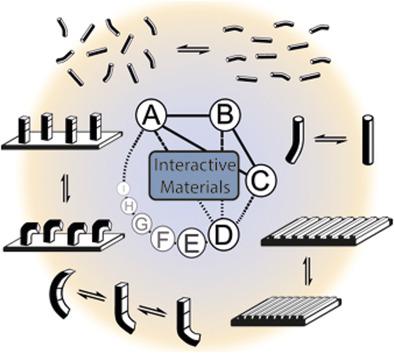当前位置:
X-MOL 学术
›
Adv. Mater.
›
论文详情
Our official English website, www.x-mol.net, welcomes your
feedback! (Note: you will need to create a separate account there.)
Design Principles for Aqueous Interactive Materials: Lessons from Small Molecules and Stimuli-Responsive Systems.
Advanced Materials ( IF 27.4 ) Pub Date : 2020-03-29 , DOI: 10.1002/adma.201906890 Jade A McCune 1 , Stefan Mommer 1 , Christopher C Parkins 1 , Oren A Scherman 1
Advanced Materials ( IF 27.4 ) Pub Date : 2020-03-29 , DOI: 10.1002/adma.201906890 Jade A McCune 1 , Stefan Mommer 1 , Christopher C Parkins 1 , Oren A Scherman 1
Affiliation

|
Interactive materials are at the forefront of current materials research with few examples in the literature. Researchers are inspired by nature to develop materials that can modulate and adapt their behavior in accordance with their surroundings. Stimuli-responsive systems have been developed over the past decades which, although often described as "smart," lack the ability to act autonomously. Nevertheless, these systems attract attention on account of the resultant materials' ability to change their properties in a predicable manner. These materials find application in a plethora of areas including drug delivery, artificial muscles, etc. Stimuli-responsive materials are serving as the precursors for next-generation interactive materials. Interest in these systems has resulted in a library of well-developed chemical motifs; however, there is a fundamental gap between stimuli-responsive and interactive materials. In this perspective, current state-of-the-art stimuli-responsive materials are outlined with a specific emphasis on aqueous macroscopic interactive materials. Compartmentalization, critical for achieving interactivity, relies on hydrophobic, hydrophilic, supramolecular, and ionic interactions, which are commonly present in aqueous systems and enable complex self-assembly processes. Relevant examples of aqueous interactive materials that do exist are given, and design principles to realize the next generation of materials with embedded autonomous function are suggested.
中文翻译:

水性交互材料的设计原理:小分子和刺激响应系统的经验教训。
交互式材料是当前材料研究的最前沿,文献中很少有实例。研究人员受到大自然的启发,开发出可以根据周围环境调节和适应其行为的材料。在过去的几十年中,已经开发出了刺激响应系统,尽管通常被描述为“智能”,但它们缺乏自主行动的能力。然而,由于所得材料以可预测的方式改变其性能的能力,这些系统引起了关注。这些材料可用于许多领域,包括药物输送,人造肌肉等。刺激反应性材料是下一代交互式材料的前身。对这些系统的兴趣导致建立了完善的化学基序库。然而,刺激响应和互动材料之间存在根本的鸿沟。从这个角度出发,概述了当前最先进的刺激响应材料,特别强调了水性宏观互动材料。间隔化对于实现交互性至关重要,它依赖于水性系统中常见的疏水,亲水,超分子和离子相互作用,并使复杂的自组装过程成为可能。给出了确实存在的水性交互材料的相关示例,并提出了实现具有嵌入式自主功能的下一代材料的设计原理。概述了当前最先进的刺激响应材料,重点是水性宏观交互材料。间隔化对于实现交互性至关重要,它依赖于水性系统中普遍存在的疏水,亲水,超分子和离子相互作用,并使复杂的自组装过程成为可能。给出了确实存在的水性交互材料的相关示例,并提出了实现具有嵌入式自主功能的下一代材料的设计原理。概述了当前最先进的刺激响应材料,重点是水性宏观交互材料。间隔化对于实现交互性至关重要,它依赖于水性系统中普遍存在的疏水,亲水,超分子和离子相互作用,并使复杂的自组装过程成为可能。给出了确实存在的水性交互材料的相关示例,并提出了实现具有嵌入式自主功能的下一代材料的设计原理。
更新日期:2020-03-29
中文翻译:

水性交互材料的设计原理:小分子和刺激响应系统的经验教训。
交互式材料是当前材料研究的最前沿,文献中很少有实例。研究人员受到大自然的启发,开发出可以根据周围环境调节和适应其行为的材料。在过去的几十年中,已经开发出了刺激响应系统,尽管通常被描述为“智能”,但它们缺乏自主行动的能力。然而,由于所得材料以可预测的方式改变其性能的能力,这些系统引起了关注。这些材料可用于许多领域,包括药物输送,人造肌肉等。刺激反应性材料是下一代交互式材料的前身。对这些系统的兴趣导致建立了完善的化学基序库。然而,刺激响应和互动材料之间存在根本的鸿沟。从这个角度出发,概述了当前最先进的刺激响应材料,特别强调了水性宏观互动材料。间隔化对于实现交互性至关重要,它依赖于水性系统中常见的疏水,亲水,超分子和离子相互作用,并使复杂的自组装过程成为可能。给出了确实存在的水性交互材料的相关示例,并提出了实现具有嵌入式自主功能的下一代材料的设计原理。概述了当前最先进的刺激响应材料,重点是水性宏观交互材料。间隔化对于实现交互性至关重要,它依赖于水性系统中普遍存在的疏水,亲水,超分子和离子相互作用,并使复杂的自组装过程成为可能。给出了确实存在的水性交互材料的相关示例,并提出了实现具有嵌入式自主功能的下一代材料的设计原理。概述了当前最先进的刺激响应材料,重点是水性宏观交互材料。间隔化对于实现交互性至关重要,它依赖于水性系统中普遍存在的疏水,亲水,超分子和离子相互作用,并使复杂的自组装过程成为可能。给出了确实存在的水性交互材料的相关示例,并提出了实现具有嵌入式自主功能的下一代材料的设计原理。











































 京公网安备 11010802027423号
京公网安备 11010802027423号